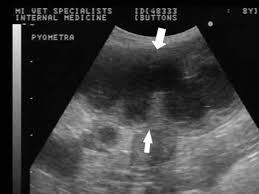The female dog killer disease preventable by a simple operation
WHAT IS IT?
Pyometra (which literally translates as “pus in the womb”) is a uterine infection due to a hormonal abnormality that affects female dogs (but it has also been observed in intact or unneutered/unspayed cats, ferrets, guinea pigs, hamsters, rats, and rabbits), and experts recommend it be treated “quickly and aggressively.” It is often accompanied by a secondary bacterial infection, and if left untreated, can be fatal.
WHICH DOGS ARE AFFECTED BY PYOMETRA?
Unspayed female dogs and cats who are sexually mature which suffer years of heat cycles without pregnancy. It usually affects female dogs who are six years old or older, though it has been seen in younger dogs.
WHEN AM I MOST LIKELY TO NOTICE SYMPTOMS IN MY DOG?
After she concludes a heat cycle; if these symptoms (see list in article on right) occur, bring her to a veterinarian immediately. Remember that the bloody pus discharge may not always manifest, especially in cases of closed cervix pyometra.
Pyometra is a relatively common hormonally mediated disease in the female dogs that usually is undetected at first in its developing stages until there are noticeable signs:
- Lack of appetite
- An enlargement of the abdominal area as a result of the accumulation of pus and other exudates in the “horns” of the uterus
- Fever may or may not be present
- For the most part, owners notice an abrupt decline in appetite.
- There is also a noticeable lethargic behaviour that was previously unnoticed in the dog.
- Some of my patients have excessive, and or frequent urination as well as excessive thirst displayed in your pets. (PU/PD in veterinary medical jargon)
- Frequent vomiting is also observed.
For the avid enthusiast as well as dog lovers, the signs are seen at around 4=8weeks after estrus or “heat” in the intact (not spayed or neutered) dog. So please be warned of the above signs that must not be ignored by the owner. Otherwise, this may result in shock and death.
DETECTION
Physical examination as well as history-taking is always done in a veterinary clinic. In my experience, distension of the abdominal cavity is observed, with or without a purulent (pus-like discharge), necessitating more tests. These include diagnostic imaging as well as haematology and a serum chemistry panel.
A previously healthy female dog that suddenly slumps into a malaise of sorts will, upon serum chemistry, reveal high BUN (blood urea nitrogen) as well as creatinine. The issue of bacterial endotoxins that harm visceral organs, particularly the kidney, due presumably to immune-complex deposition, was a common finding in most of my patients coming in for this particular disease. However, upon removal of the ovary and uterus, glomerulonephropathy (kidney disease) is restored to normal.
Other causes of symptoms of illness similar to the above should be ruled out by a board-certified veterinarian who is well-trained to perform these procedures.
TREATMENT

Why should a veterinarian resort to ovariohysterectomy? This procedure is the only guaranteed treatment of choice that cures the condition. In the initial stages of cystic endometrial hyperplasia (thickening of the endometrial lining), if it is early into the disease, there is hope for antibiotic therapy. If, however, I see that the canine patient, upon presentation, is already in no condition to wait any longer, surgery should be done.
When pus has accumulated in the uterus to an extent that the imminent danger of shock is present, I’d rather operate as soon as possible given that the animal’s age and blood chemistry test results are deemed within considerably safe parameters. To wait any longer may cause a precipitous slump to graver consequences.
Upon removal of the ovary, the issue of hormonal influence is dealt with once and for all. Obviously, when the uterus is removed, the exudates (fluids, pus) will be excluded. Having said thus, excellent post-operative care and treatment is necessary. Fluid, electrolytes, as well as acid-base imbalances must be corrected alongside all treatment regimens mentioned. The bacterial infection in the uterus is the primary cause of the illness. Prognosis is good when the dog is operated on early.
AN OUNCE OF PREVENTION…
As a side note, preventive measures versus the disease must be undertaken since the cost of surgery is high. Spaying or ovariohysterectomy is best done in an animal that is not favored for breeding while it is still young. Spaying is the best option of all since it is also a risk-reducing measure for a variety of other diseases. It is also a good way of reducing the numbers of unwanted or uncared for dogs that literally roam around the neighborhood.
This appeared in Animal Scene’s March 2017 issue.






